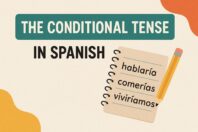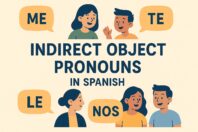How to Express Possession in Spanish: A Simple Guide

Get our free email course, Shortcut to Conversational.
Have conversations faster, understand people when they speak fast, and other tested tips to learn faster.
More infoWhat are the words to express possession in Spanish? That’s my dog. It’s her house. Is that your food? And so on.
Luckily, we have a set of possessive words in Spanish that are almost as easy as in English. Still, there are a few key differences, like that there is a plural form as well, and that there are different possessive words for the different forms of you in Spanish.
In today’s simple guide, we’ll take you through each of the basic forms of possessive adjectives in Spanish.
Possession in Spanish, explained
In English, you have: my, your, his, her, its, our, their. In Spanish, we have mi(s), tu(s), su(s), vuestro/a(s), nuestro/a(s). In both languages, these are known as possessive adjectives, and are sometimes just referred to as the possessives.
The main differences are that these possessive words in Spanish have both singular and plural forms, while vuestro and nuestro also have both masculine and feminine forms. We’ll explain each of these in detail in the next sections, and include a table of them all in the conclusion.
So how do you show possession in Spanish with these words? Just like in English, these go before a noun. If the noun is plural, we use the plural form of the possessives in Spanish. In practice, these follow the same rules as other adjectives in Spanish.
For instance, “my dog” is “mi perro.” If I have two dogs then the plural of “my dogs” becomes “mis perros”. That’s it – we just add -s at the end of the “mi” if the noun is plural.
For most of these, it doesn’t matter if our possessions in Spanish are masculine or feminine. The exceptions are with vuestro and nuestro, which we’ll explain when we see them below.
Before we get into each of our possessives we should mention that we’re intentionally keeping this lesson simple. There’s actually a second set of words to express possession in Spanish that we’re not covering here, since they’re less common. For an in-depth lesson, check out our post on all the Spanish possessive adjectives. We also have a post on the possessive pronouns, such as mine and yours in Spanish. We cover all of these and more in this detailed video on expressing possession in Spanish:
Now let’s see each of these possessive words in Spanish!
My in Spanish: Mi, Mis
My in Spanish singular is mi. It can be used before any singular noun.
- Soy profesor, me gusta mi trabajo. – I am a teacher, I like my job.
- Mi madre es hermosa. – My mother is beautiful.
When do you use mis in Spanish? Well, my in Spanish plural is mis, so you use it when the noun is plural.
- Mis hermanos son mexicanos. – My brothers are Mexican.
- Mis zapatos están demasiado sucios. – My shoes are too dirty.
Your (informal singular) in Spanish: Tu, Tus
Do you know the two words for singular you in Spanish? Tú is informal and is the second-person pronoun, while usted is formal and is a third-person pronoun.
When we’re talking to a single person who we address as tú, your in Spanish is tu if the noun is singular, and tus if the noun is plural.
- ¿Te gusta tu trabajo? – Do you like your job?
- Olvidaste tu maleta. – You forgot your suitcase.
We only use tus when we’re talking to one person, when whatever that person possesses is in plural.
- ¿Dónde están tus amigos? – Where are your friends?
- Guarda tus juguetes. Tus abuelos vienen de visita. – Put away your toys. Your grandparents are coming to visit.
We know, the subject pronoun tú looks a lot like its possessive adjective tu, and indeed they’re pronounced exactly the same way. Just remember that accent marks in Spanish are integral parts of words, allowing us to always differentiate between tú vs tu!
Third-person singular: Su, Sus
In Spanish, we use the same possessives for each grammatical person, so there’s no difference between his, her, and its. And since the formal singular you form, usted, is also considered a third-person pronoun, it also uses the same words for your.
So whether our subject is él, ella, or usted, the possessive is always su for singular possessions and sus for plural possessions. (There’s no gender-neutral subject pronoun for it in Spanish, since all nouns are either masculine or feminine.)
His in Spanish: Su, Sus
- Él está pintando su casa. – He is painting his house.
- Él contó su vida en un libro. – He told [the story of] his life in a book.
- Leonardo no pudo viajar con sus amigos. – Leonardo couldn’t travel with his friends.
- Pedro compartió sus dulces con sus hermanas. – Pedro shared his candies with his sisters.
Her in Spanish: Su, Sus
- Ella está pintando su casa. – She is painting her house.
- Sarah está casada. Su esposo trabaja conmigo. – Sarah is married. Her husband works with me.
- Daniela mintió a sus padres sobre su novio. – Daniela lied to her parents about her boyfriend.
- Mariana se arregló para la fiesta. Sus aretes eran hermosos. – Mariana got all done up for the party. Her earrings were beautiful.
Its in Spanish: Su, Sus
- Estamos estudiando al Japón y su cultura. – We are studying Japan and its culture.
- Ese restaurante es muy bueno. Su comida es deliciosa. – That restaurant is really good. Its food is delicious.
- Esta bicicleta no es segura. Sus frenos no funcionan. – This bike isn’t safe. Its brakes don’t work.
- Medellín es hermoso, me encanta sus parques. – Medellin is beautiful, I love its parks.
Your (formal) in Spanish: Su, Sus
- Buenos días señor. Su primer cliente está en su oficina. – Good morning, sir. Your first client is in your office.
- Aquí está su llave. Su habitación está en el tercer piso del hotel. – Here is your key. Your room is on the third floor of the hotel.
- Lo siento, señora, pero sus perros no pueden entrar al restaurante. – I’m sorry, ma’am, but your dogs can’t come inside the restaurant.
- Si usted gasta más de $50, le entregaremos sus compras gratis. – If you spend more than $50, we’ll deliver your groceries for free.
Our in Spanish: Nuestro, Nuestra, Nuestros, Nuestras
We have two first-person plural subject pronouns for we in Spanish: nosotros and nosotras. It doesn’t matter if we is feminine or masculine, since both of these use the same four possessive adjectives. The possessives just need to match the gender and number of the possessed nouns.
Nuestro is used when the possessed noun is singular and masculine, while nuestra is for when the possessed noun is singular and feminine.
- No queremos gastar todo nuestro dinero. – We don’t want to spend all our money.
- Debemos reservar nuestro vuelo. – We must reserve our flight.
- Nuestra hija fue aceptada en la universidad. – Our daughter got accepted to university.
- Necesitamos pintar nuestra casa este verano. – We need to paint our house this summer.
Our in Spanish plural is nuestros when the possessed nouns are masculine, while nuestras is for when the possessed nouns are feminine.
- Nuestros amigos son muy chéveres. – Our friends are so cool.
- Nuestros oponentes en el partido están muy nerviosos. – Our opponents in the match are very nervous.
- ¡Me encanta que nuestras faldas combinen hoy! – I love that our skirts match today!
- Nuestras hijas comparten un dormitorio con literas. – Our daughters share a bedroom with bunk beds.
Your (informal plural) in Spanish: Vuestro, Vuestra, Vuestros, Vuestras
In Spain, vosotros and vosotras are used as the plural counterparts to the informal you, tú. In Spanish grammar, these are the second-person plural pronouns, with their own verb conjugations and associated possessives. These are rarely used in Latin American Spanish, however, since ustedes is used as the only plural you. We explain vosotros vs ustedes in our post on all the different forms of You in Spanish.
The gender of the group we’re addressing needs to be reflected in the subject pronoun, with vosotros as the plural you for an all-male or a mixed-gender group of people, and vosotras for an all-female group. When we use the associated words to express possession in Spanish, however, the gender of the group no longer matters. We use vuestro/a(s) for both vosotros and vosotras, changing the ending to reflect the gender and number of what is possessed.
When we’re addressing vosotros/as, the associated possessive for your in Spanish is vuestro when the group possesses a single masculine thing, or vuestra when their possession is singular and feminine.
- Hola chicos. Creo que vi a vuestro profesor de español en el centro comercial. – Hey guys, I think I saw your Spanish teacher at the mall.
- Ya es tarde, niños. Es hora de terminar vuestro juego. – It’s late, kids. It’s time to finish your game.
- Nos vamos ahora. Llegaremos a vuestra casa en media hora. – We’re leaving now. We’ll get to your house in a half hour.
- ¡Bravo, amigos! Vuestra banda tocó muy bien esta noche. – Bravo, my friends! Your band played so well tonight.
When we’re addressing vosotros/as and their possessions are masculine plural, the associated your in Spanish plural is vuestros. When their possessions are feminine plural, it’s vuestras.
- ¡Cuidado con vuestros perros! Están corriendo por toda la casa. – Watch out for your dogs! They’re running all over the house.
- ¿Tenéis vuestros pasaportes listos para el viaje? – Do you have your passports ready for the trip?
- Vosotras y vuestras compañeras de equipo habéis hecho un gran trabajo en el torneo. – You girls and your teammates have done a great job in the tournament.
- ¿Tenéis vuestras toallas para la playa? El día está perfecto para nadar. – Do you have your towels for the beach? It’s a perfect day for swimming.
Third-person plural: Su, Sus
As we saw with the third-person singular, the same Spanish possessive words are used for all the third-person plural subjects. They in Spanish can be either ellos or ellas. The plural you corresponding to usted is ustedes, which is also treated as a third-person pronoun in Spanish grammar. Ustedes is used as the formal plural you in Spain, while in Latin American Spanish ustedes is the plural you for everyone.
The associated words to express possession in Spanish are su for singular possessions, and sus for plural possessions. There’s no differentiation for gender. These are exactly the same possessive words that we use in the third-person singular, so only through context can we tell if su and sus mean his, her, its, their, or your.
We’ll show some examples here where su and sus are used as their in Spanish for third-person plural subjects, and your in Spanish when addressing plural ustedes.
Their in Spanish: Su, Sus
- Las niñas visitan a su padre cada dos fines de semana. – The girls visit their father every other weekend.
- Mis abuelos compraron su casa antes de que nacieran mis padres. – My grandparents bought their house before my parents were born.
- Las leonas comparten sus presas con sus cachorros. – The lionesses share their kills with their cubs.
- Nuestros nuevos vecinos son de Ucrania. Sus nombres son muy complicados. – Our new neighbors are from Ukraine. Their names are very complicated.
Your (plural) in Spanish: Su, Sus
- Ustedes aman a su gatito. – You guys love your kitten.
- Señor y señora, su mesa está lista. – Sir, Ma’am, your table is ready.
- Por favor apaguen sus celulares. – Please turn off your cellphones.
- Ustedes tienen que tomar sus propias decisiones. – You all have to make your own decisions.
Conclusion: Expressing possession in Spanish
Today we presented our easy guide of words to express possession in Spanish. We stuck with the basics, learning the possessive words in Spanish that are equivalent to your possessive adjectives in English. For a more in-depth lesson, we’ll refer you to our post with all of the possessive adjectives. We also have a related post on the possessive pronouns.
For singular subjects in English, you have: my, your, his, her, its. Since our rules for how to show ownership in Spanish depend on whether the possessed thing is in singular or plural, our equivalents are: mi, mis, tu, tus, su, sus. Since we use usted as a formal third-person pronoun for you, we also use su and sus as the corresponding your in Spanish.
For plural subjects in English, you have: our, your, their. Our rules in Spanish differentiate between both the number and gender of the possessed things for the first- and second-person plural possessives, so we have four possible versions each of our in Spanish (nuestro, nuestra, neustros, nuestras) and informal your in Spanish (vuestro, vuestra, vuestros, vuestras). We use the same two options to refer to our possessions in Spanish with third-person plural subjects, so su and sus can also mean their in Spanish (for ellos and ellas) and your in Spanish (for ustedes).
To sum up all the words to express possession in Spanish we’ve seen today, we’ll leave you with this table that shows them all in Spanish and English. To see how well you’ve learned them, give the exercises a try at the end of the post!
| Owner | Singular possession | Plural possessions | English possessive adjective |
| Yo | Mi | Mis | My |
| Tú | Tu | Tus | Your (singular informal) |
| Él / Ella / Usted | Su | Sus | His / Her / Its / Your (singular formal) |
| Nosotros/as | Nuestro/a | Nuestros/as | Our |
| Vosotros/as | Vuestro/a | Vuestros/as | Your (plural informal) |
| Ellos / Ellas / Ustedes | Su | Sus | Their, Your (plural) |
Possession in Spanish Quiz
Complete each sentence with the correct possessive words in Spanish and English. Since the subject and the owner aren’t all the same, we’ve included the owner in parentheses for every sentence.
Remember to choose the right form of possessive adjective to reflect the number and gender of whatever is possessed, in addition to choosing the right word to match the owner! The answers are below.
1. Conocí a _____ (ella) familia. – I met _____ family.
2. Visité a _____ (yo) doctor. – I visited _____ doctor.
3. Llevé _____ (nosotros) hijos al parque. – I took _____ kids to the park.
4. Él contó _____ (él) vida en el libro. – He told _____ life in the book.
5. Ella perdió _____ (ella) cartera. – She lost _____ purse.
6. Ellas vieron al deportista y admiraron _____ (el) cuerpo. – They saw the athlete and admired _____ body.
7. Luis no pudo viajar con _____ (él) amigos. – Louis coudn’t travel with _____ friends.
8. Fue un placer conocer a _____ (tú) padres. – It was a pleasure to meet _____ parents.
9. Vamos a cumplir _____ (nosotros) meta. – We’ll achieve _____ goal.
10. Él es _____ (yo) mejor amigo. – He is _____ best friend.
Answers
1. Conocí a su familia. – I met her family.
2. Visité a mi doctor. – I visited my doctor.
3. Llevé nuestros hijos al parque. – I took our kids to the park.
4. Él contó su vida en el libro. – He told his life in the book.
5. Ella perdió su cartera. – She lost her purse.
6. Ellas vieron al deportista y admiraron su cuerpo. – They saw the athlete and admired his body.
7. Luis no pudo viajar con sus amigos. – Louis coudn’t travel with his friends.
8. Fue un placer conocer a tus padres. – It was a pleasure to meet your parents.
9. Vamos a cumplir nuestra meta. – We’ll achieve our goal.
10. Él es mi mejor amigo. – He is my best friend.



